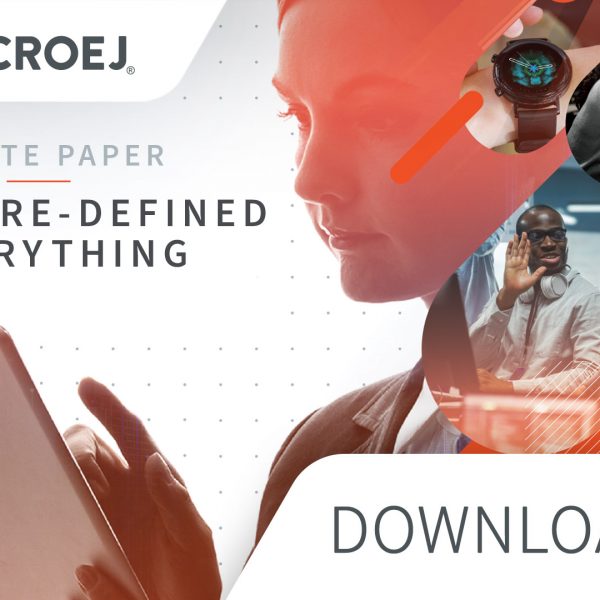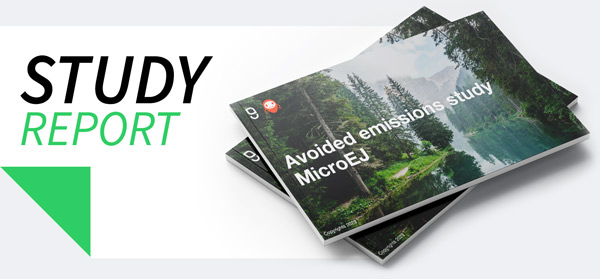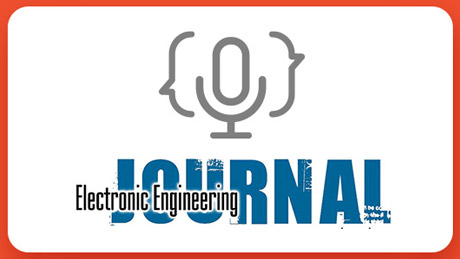Ryan Chacon – Welcome Semir to the IoT For All Podcast. Thanks for being here this week.
Semir Haddad – Hello, Ryan. Thank you for having me on this podcast.
R.C. – It’s great to have you. Before getting into our conversation, I wanted to have you do a quick introduction about yourself and the company for our audience.
S.H. – I’m a veteran in the embedded space and the IoT space. So, I’ve started my life as an engineer, and I developed broad embedded software. I got four patents for various projects I have done, then moved to the product side, and I was in the semiconductor industry with STMicroelectronics. I created the STM32 there. I was the original product owner of the whole STM32 product line, which is now very popular. I also work with Renesas Electronics, and I was managing the microcontrollers and microprocessors for Renesas for all the American regions. And then, recently, I joined the MicroEJ as a product, Chief Product Officer, and Chief Strategy Officer. And at MicroEJ, what we do, we provide, we bring the software capabilities that you have and say you have you, that exists in the cloud and the IT space for a long time in the embedded space. And we do that by providing what you call a virtual execution environment, which is a unique virtualization and containerization software that allows people to write code as if they were a containerized application and using a high-level language. And this comes with many benefits in terms of time to market, isolation of hardware, ability to use hardware with the same code, and reuse and port your code very easily. And the company is has been in the business for a little around 10 years and we are based in France and the USA.
R.C. – So, I wanted to jump into a topic that I thought was really interesting to talk about based on your all’s approach and expertise. And the topic is software-defined, or the, I guess, it’s more of a software defined trend in the world of IoT that’s happening or starting to happen. What does that mean exactly?
S.H. – This is a subject dear to my heart because we’re a software company with hardware roots. And I’m personally, I’m a hardware expert with software collaboration. And Fred Rivard, our CEO, is a software expert, is a computer science guy, pure computer science with hardware collaboration. So, it’s a very good combination. And what we do is bring this software capability to the IoT space. And when you speak about software-defined, it’s a trend that has been in the industry for a very long time. If you think about it, the very software, the very first software-defined thing was a software-defined radio that people, when they developed radio, they used to develop everything in hardware. And then a guy once said, oh, let’s try to softwareize that and make it more programmable. And this was the very first one, then you saw coming software-defined networks when people were building big networks, let’s say, and like particularly cellular networks, something like that, they say, what, why don’t we make it more programmable, more portable, more flexible. And then the latest trend in software-defined is a software-defined car. You may hear the people in automotive say, oh, we are developing the software-defined car. And they try to, for the same, put everything more flexible, portable, and agile. And that’s basically the idea of software-defined. Software-defined means that you define you have a product that used to be purely hardware. So typically, in the IoT space, all the products were purely hardware, even mechanical. If you think about a meter, it used to be an electricity meter, and it used to be just a mechanical meter. Now it’s hardware plus software. But people still develop as if it were hardware. So, they have, they use method, the methodology where they have a waterfall method and they define everything from the start and then develop it, and it’s not flexible. And the software-defined trend means that make all this more like a software product, exactly like when you develop mobile phone application, or when you develop cloud application.
R.C. – Okay, so the other pieces of the solution, the hardware, the connectivity, and things like that, how is that viewed when you’re thinking about more defining things based on the software, and are the other things more just accompanying it in order to allow the solution to collect information, connect, send the data back and forth, those kinds of things, or how is that, how does everything fit together when you’re coming at it from a software-defined kind of approach?
S.H. – Yeah. So, when you come up with a software-defined approach, the main thing that I would say is very relevant for the IoT is that you develop with the idea that your software will evolve a lot. So that’s the main difference, and the main mindset is exactly like in software. If you think about, you talk about; we talk with software people in the cloud or in IT, they just do sprints, that they have agile methodology and they do sprints, and every, let’s say 15 days, there is a new version of the product, a new version of the product. And this is something that was unheard of in the IoT space. That means this will happen. So, this will happen, look, more updates. That’s one aspect. Very often, updates and then using the connectivity part of the IoT, the fact that you’re always connected, you can also provision new services to your device. So, your device will become another type of device. We, with the life of the, during the product’s life, and this comes with two aspects. One is that you can customize your product later after shipment, and then you can also bring new services to monetize the benefits of a software-defined approach.
R.C. – And let me ask the last question around this topic is if I am listening to this, what are the biggest benefits of the software-defined trend for businesses? You mentioned flexibility, being more agile, things like that, but just to sum it up, what are those big benefits that are, that approaching it from this side versus maybe how things have been done before that people don’t realize or need to understand?
S.H. – The first benefit is that you can have a product that is much more tuned to the end customer. You can segment for niche markets very easily because you use software that is very flexible, so it’s very easy for you to create a software for your hardware that is dedicated for each niche. Okay, so that is the first aspect. So, we call it, and they call that hyper segmentation. For example, we have one customer, Office Zebra, that is developing printers. They were able to customize the printer for their end user. So, for instance, one of their end users was FedEx. They have a printer, especially for FedEx, with everything tuned for FedEx. And then, one of our customers was UPS, and they wrap everything for UPS. It was very customized for UPS. So that’s one aspect. So, there’s customization hyper segmentation. So that’s one. The second thing that you could benefit for the company is you can also, as I said, add services after the fact. And this is, we can call them apps. It’s really like your mobile phone apps when you download apps, except that it’s in the context of a business to business, or it could be also a business to consumer aspect, but so this enables you to create really new services and new product. And we have one case with Landis+Gyr, one of our customers in the metering space. So, they have an electricity meter. They call it a Revelo. This electricity meter is customizable by the utility companies, and utility companies can provide, can provision some applications of services, like for instance, how to manage your solar panels or how to manage your electricity and so on, and that helps them manage the grid and that also help them provide paid services to the end customer, the end user.
R.C. – One of the things I wanted to ask you. So, when we’re talking about software and building IoT solutions, sustainability is a topic that comes up a lot. Especially now, it’s more of a hot topic to discuss. So, tell me about your all’s perspective or just how do you think about sustainability when it comes to IoT because there is this. I have heard the phrase thrown around green software, and I’d like to better understand what that exactly means. Because when we think about software, a lot of our listeners think about software, we don’t think about it in any other way or really connected necessarily to sustainability. So, what does green software mean, and how does that kind of contribute to the sustainability goals that a lot of companies have when it comes to IoT?
S.H. – So sustainability is very, it is a very important topic right now in the industry. So, you know that today the old ICT, I’d say IT and communication and telecommunication contribution to the greenhouse gas is like 4%. But it’s planned to be 14% by 2030. So, it’s pretty, pretty high. It’s starting to grow because all the other industries are reducing their footprint, like even the big contributors, so now it’s very visible, everything related to electronics. So, it’s definitely, as you said, many companies have this climate pledge, and they want to do better for the climate. And when we talk, think about IoT products. It has an impact because it’s not because the product is consuming a lot; the negative product doesn’t consume much, but because there are so many of them. So, we have to think about like 30 billion IoT products, connected IoT products, that’s a lot of products. So, even a small contribution can have a big impact. One, once you talk about green software is means that, okay, let’s, you can, there are different ways to do software, but there is a way, let’s do a, let’s do it in a way that is the most optimized in terms of power. And what it means it starts already with the choice of the platform that you use for your software development. As I mentioned, there’s a strength for software-defined products. So, everybody’s moving and jumping on the train. But there are several ways to do it, to achieve it. And one way, which is the way that many people coming from the IT world took, is to say we have Linux and Android technology that works in the cloud. Let’s use it in IoT products. And that gives you products like the Google Nest Thermostat, which is Linux Android-based, or I would say the Android watch, which is completely based on Android. So you can have wireless watches and so on, but these, the problem with this technology they are perfectly good in terms of software, and they are very great to do software-defined solutions, but they require lots of hardware resources. So, lots of memory, lots of performance, and at the end, lots of, they consume a lot of power. What is the best approach when you want to do good for the planet is to optimize, to choose a solution that is optimized. And at MicroEJ, that’s really what we provide. In fact, we, people call us the tiny sibling of Android. So, it’s really like the same technology as you have with Android but 1,000 times more optimized. So, we can run on microcontrollers and starting with Cortex-M0. So, very simple microcontrollers. And that means that you use a product that is less costly. So, costs as a, I would say the hardware as a, it’s around 50 to 80 percent of the contribution for the greenhouse emission. So, already choosing a hardware that is less costly, that is smaller, you save a lot of gas. And then it is much better in terms of power. For instance, one of our customers, Polar, has a smartwatch that is powered by MicroEJ, and they are able to move from one day with the Android watch to more than seven days of operation with a single charge. So, this is, yeah, this is the best way. In fact, to do green software is to use the most optimized hardware for your software. Sustainable design performance trade-offs
R.C. – Do you ever run into situations where you’re not able, not necessarily you all, but is there ever a situation that you could envision where there’s, you’re not able to maybe develop it as sustainably as you’d like to because of it creates too limiting of the experience for what the use case requires from either a power consumption standpoint, or is there always ways that optimization can be done, it just may only go to a certain extent because obviously, you can’t pull everything out of a solution that needs certain power consumption, needs certain different elements that are important to it. Like how do you, is that something ever that you have to worry about?
S.H. – I think it’s a trade-off. What we see is that it must be, you need to be serious about your green initiative, and sometimes some companies just do some greenwashing. So, they say, yeah, we do green, but when you talk to them, they say no, we want to do this. That is going to performance. It’s better for us, and cost is more important than green. I would say the objective here of being green is to be at the same level as objective. And if it’s at the same level objective is that you can put the time and effort to the best optimized solution. So, it’s really about putting the time and effort into this.
R.C. – When it comes to the design elements of it, and you’re thinking about all the different pieces, what does it mean when you say sustainable design principles? Is that just the best practices and the things that you try to follow when it comes to designing the system and the solution as a whole? Is that kind of when that’s used, is that what you’re talking about?
S.H. – To put the the optimization at the core of your design. So not, what we see again is company that for the comfort of the engineer, so because they like some tools or some software, they will choose a solution that is completely suboptimal. So, in fact, we are reading and pressure if you follow the industry, there is a big, I would say, lots of pressure around the Kubernetes and containers for this kind of Docker solution for the embedded space. But this is again, very unoptimized, very costly. So, if you want to use Docker and Kubernetes for your embedded space at one time, Microsoft tried to do that, which they said, oh, we’re going to put Kubernetes and Docker everywhere, means that you need very powerful hardware with lots of power consumption and lots of cost. It’s not sustainable at all. It’s just for the comfort of the engineer. This is definitely not a system, there is a better way. You have really to think about, okay, no, that’s, sustainability is our goal, and the comfort of the engineer will come after. But there are solutions that provide almost the same comfort and the same functionality as I’d say the virtual containers from MicroEJ.
R.C. – Well, Semir, thank you so much for taking the time to chat about this. We’ve talked about sustainability before, but we really haven’t broken down and talked more in depth about the elements that go into really contributing sustainability on the software side and the software development side. So that software-defined trend, the green software that we’re talking about today, so I’m glad we were able to explain that to our audience and really shed light on what’s going on. It sounds like there’s a lot of exciting things going on at MicroEJ regarding how you all are able to bring these solutions to life and follow these principles, and really build something that does meet these sustainability topics that we’re talking about. Learn more and follow up. For our audience who wants to learn more, follow up, engage further, what’s the best way they can do that?
S.H. – Yeah, sure. They can go to our website, www.microej.com, and they can also contact me on LinkedIn. So, I’m on LinkedIn. So Semir Haddad, just send me a message, and I will reply.
R.C. – Semir, thank you again so much. I look forward to getting this out for our audience.
S.H. – Thank you very much, Ryan.





